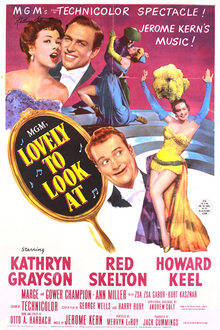Plot
Broadway producers Al Marsh, Tony Naylor, and Jerry Ralby are desperately searching for investors to finance their new show. The investors decline to finance due to their lack of startup funds. Backstage inside Bubbles Cassidy's dressing room, Al—whose real family name is Wodzscyngkic—receives a letter from Paris, notifying him that his aunt Roberta has died and has left him half of her dress salon business. With their own funds, the producers travel to Paris in hopes of selling Al's share in the shop.
When they arrive, Al meets Stephanie and Clarisse, two sisters whom Roberta adopted that own the other half of the dress shop. Downstairs, Tony grows frustrated at waiting, only to learn the dress shop is in severe debt. They leave discouraged, but decide to expand the business with a lavish nightclub featuring fashion shows. Al however declines to propose the idea to Stephanie, knowing she would disapprove. Jerry returns to the shop, and because he is attracted to Clarisse, he proposes glamorizing her fashion designs. Tony returns to Stephanie's office and describes his intentions, but she declines feeling the creditors would not approve. During the creditors' meeting, Tony marches in and demands they finance the nightclub.
Shortly after, Bubbles arrives and resumes her relationship with Tony, which disappoints Stephanie who has fallen in love with him. At the nightclub, the three couples, along with Zsa Zsa and her friend Max Fogelsby, enjoy champagne together. Tony and Stephanie dance together, which infuriates Bubbles. Before she leaves, Bubbles leaves with Al in a taxi cab where he develops an attraction to her. Meanwhile, Stephanie leaves with Tony on a hansom cab where they kiss until she passes out. Alone together, Jerry and Clarisse dance together and realize their mutual attraction.
The next morning, Tony arrives but Stephanie has a hangover as she has forgotten what happened last night. Tony reminds her of their kiss and they admit their love towards each other. Sometime later, the men invite investors to a comedy routine performed by Al. This succeeds, and Zsa Zsa's friend Max offers to finance the Broadway show in New York, which delights Tony. This disappoints Stephanie as Tony feels torn between her and his desire to finance the show.
Tony returns to New York, but feels guilty for betraying his friends. He withdraws from producing the show, which has stalled in progress. Max understands Tony's feelings, and sends him back to Paris to help the struggling fashion show finale. Tony apologizes to his friends and helps to have the finale ready for the night. The finale becomes successful, where Tony and Stephanie dance together, as do Clarisse and Jerry, and Al and Bubbles.
Production
The film was originally announced as a vehicle for Gene Kelly and Frank Sinatra, who had teamed together several times previously. They would have co-starred with Judy Garland and Betty Garrett [3] [4]
Aside from keeping the musical score and retaining the idea of a dress shop being inherited by someone, it bears almost no resemblance to the show or 1935 film. [5] [6] [4]
The finale, a fashion show, was directed by Vincente Minnelli, with costumes by Adrian, who designed more than 40 costumes for the film, at a cost of $100,000. [7]
Reception
According to MGM records, the film earned $2,571,000 in the United States and Canada, and $1,203,000 elsewhere, resulting in an overall loss of $735,000. [1]
The New York Times reviewer wrote: "The producers ... have used the full and wonderful complement of tunes from the sturdy score [of Roberta]. Thus, only the tone deaf can be apathetic to Kathryn Grayson and Howard Keel's rendition of "You're Devastating" or "The Touch of Your Hand". The bittersweet lilt of "Yesterdays", as sung by Miss Grayson, has not lost its haunting quality and the now-classic "Smoke Gets in Your Eyes" still has notes and lyrics of poetic beauty... Although all of the dance numbers choreographed by Hermes Pan are not inspired, he has inventively devised spirited turns for "I Won't Dance" and "Smoke Gets in Your Eyes" to which Marge and Gower Champion contribute professional grace, verve and charm. And Ann Miller is permitted to exhibit both her beautiful legs and her staccato tapping in a snappy run through of "I'll be Hard to Handle." Howard Keel and Kathryn Grayson, who have no need to prove their eminence as singers, again are in fine voice and make a handsome couple whose misunderstandings are inconsequential." [6]
This page is based on this
Wikipedia article Text is available under the
CC BY-SA 4.0 license; additional terms may apply.
Images, videos and audio are available under their respective licenses.
